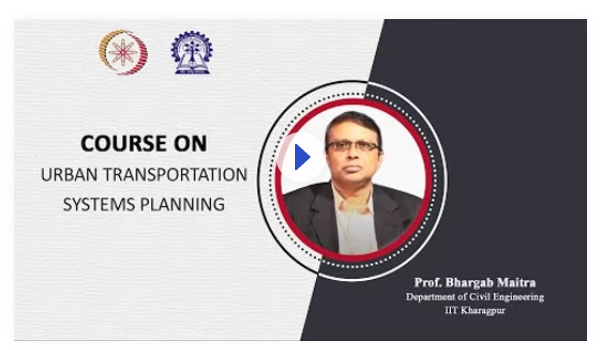Urban Transportation Systems Planning free videos and free material uploaded by IIT Kharagpur Staff .
Week 1: Module-A: Introduction to Urban Transportation Planning
Urbanization, Urban Transportation: Impacts, Behavioral Changes, Urban Transportation problems & Externalities- Congestion, Safety, Emissions, etc. Introduction to Transport planning; Transport Planning Morphology: Problem definition, Solution generation, solution analysis, Evaluation and choice, Implementation Hierarchical levels of Urban Transport Planning: Conceptual Plan, Outline plan, Master plans, statutory or advisory plans, detailed development plans
Week 2: Module-B: Overview of 4-Stage Urban Transportation Planning Process
Overview of traditional four step travel demand forecasting process: Urban Activity forecasts, Trip generation, Trip Distribution, Mode Choice, Traffic assignment Specification, Calibration, Validation and Forecasting; Information needs for Travel Demand Forecasting: Study Area, Urban Activities, Zoning, Urban Activities, Transportation System, Travel information, Types of Movements Data Collection Techniques (Home-interview survey, Commercial vehicle survey, Innovative Commercial Vehicle Tracking Methods, Intermediate Public Transport Survey, Cordon-Line Survey, Post-Card Questionnaire Survey, Registration – Number Survey, License Plate Follow-Up Survey Technique, Tag-on- Vehicle Survey)
Week 3: Module-C: Trip Generation
Introduction; Basic considerations in trip generation - amount of urban activity, character of urban activity, other considerations, special generators; Trip classification; Factors affecting trip generation Methods of trip Generation- Regression analysis, trip rate analysis, cross classification analysis; Multiple Linear Regression- Regression analysis concept; The step wise approach with examples
Week 4: Module-C: Trip Generation (Continued…) Multiple Linear Regression- Considerations for zonal based multiple regression, Considerations for household based multiple regression, matching productions and attractions Category analysis- Basic approach, specifying trip generation model (trip production model structure, trip attraction model structure, Internal- External trip generation), Trip generation model calibration (developing trip production rates, developing trip attraction rates), advantages and disadvantages Stability of trip generation model- Temporal stability, geographical stability; Trip generation model application- Trip production model application, Trip attraction model application
Week 5: Module-D: Trip Distribution Introduction, Basic considerations in Trip Distribution, P-A Matrix to O-D Matrix, Factors affecting trip distribution: Properties of transport network, spatial separation between various zones Growth factor methods- Uniform factor method, Average factor method, Detroit Method, Fratar method; Furness method Synthetic methods -Introduction to Gravity Model
Week 6: Module-D: Trip Distribution (Continued…) Gravity Model- Calibration, BPR Approach of Calibration Intervening opportunities model: Concept, Advantages, Limitations, Illustrative example, Competing opportunities model, Limitations Doubly restrained model: Concept, Calibration, Linear programming approach to Trip Distribution: Concept, limitations
Week 7: Module-E: Modal Split Introduction; Influencing factors of mode choice; Types of modal split models- Trip end type and trip interchange type; Types of modal split models - Trip end type (Southern Wisconsin Model) and trip interchange type (Diversion curve model), Limitations, Aggregate and disaggregate models, advantages of disaggregate over aggregate modelling; Elements of choice decision process; Framework for the choice process of an individual Disaggregate mode choice models- Introduction, Utility theory, Probabilistic choice theory
Week 8: Module-E: Modal Split (Continued…) Binary choice models- Binary logit model, discriminant analysis, Probit analysis; Logit model; Multinomial Logit model; Nested logit model, Estimation of logit models, Two-stage modal split models
Week 9: Module-F: Traffic Assignment General, link cost function, Person-trips and vehicle Trips, diurnal patterns of demand, Trip directions Network properties: Link, nodes, characteristics of link (capacity, free flow speed, travel time, etc.), link flows, inter-zonal flows, Network connectivity, Minimum spanning tree, shortest path, etc.; Network Algorithms: Kruskal, Prims, Dijkstra, Floyd
Week 10: Module-F: Traffic Assignment (Continued…) Route Choice Behavior: User equilibrium, system equilibrium, stochastic equilibrium, Diversion Curves: California diversion curves, Detroit diversion curves, Bureau of Public roads diversion curves Deterministic traffic assignment techniques- All-or-nothing assignment, Multi-Path Traffic Assignment,; Incremental assignment, capacity restraint assignment,; Stochastic Traffic assignment techniques; Dynamic traffic assignment techniques: Basic Concepts and Approach
Week 11: Module-G: Land Use and Transportation Introduction; Urban land use planning- land use and land cover, land use classification; Land use transportation interaction; Accessibility and mobility, Land use models Module-H: Urban Goods Movement Introduction; Classification of urban goods movement; Factors affecting goods movement; Modelling Approaches Data collection; Strategy for goods transport facility planning; Facilities required in goods terminals; Time series techniques for forecasting truck traffic
Week 12: Module-H: Urban Goods Movement (Continued…) Introduction; Classification of urban goods movement; Factors affecting goods movement; Modelling Approaches Module I: Emerging Trends in Transportation planning Activity based modelling; Spatial data infrastructure (SDI); Big Data analytics
Urban transportation is an important issue in developing countries such as India. Transportation impacts various aspects such as mobility, health of residents, economic and energy aspects in an Urban area. This course covers the challenging need for effective and efficient planning of urban transport addressing the growing travel demand in a sustainable and affordable way. This NPTEL course will help in capacity building amongst master students, policy makers, practitioners, etc. for urban transport planning and decision making, to understand urban transport in all relevant dimensions, and develop urban transport plans, programs and projects. The course will consist of following nine modules: Module-A: Introduction to Urban Transportation Planning; Module-B: Overview of 4-Stage Urban Transportation Planning Process; Module-C: Trip Generation; Module-D: Trip Distribution; Module-E: Modal Split; Module-F: Traffic Assignment; Module-G: Land Use and Transportation; Module-H: Urban Goods Movement; Module-I: Emerging Trends in Transportation PlanningINTENDED AUDIENCE :M.E. / M.Tech. Students of Transportation Engineering or equivalent specializationPREREQUISITES : NoneINDUSTRIES SUPPORT :This is a core course in all IITs, NITs and universities offering M.E. / M.Tech in Transportation Engineering and therefore recognized by companies/industries in relevant areas

- 0 Reviews
- 5 Students
- 351 Courses

Write a public review